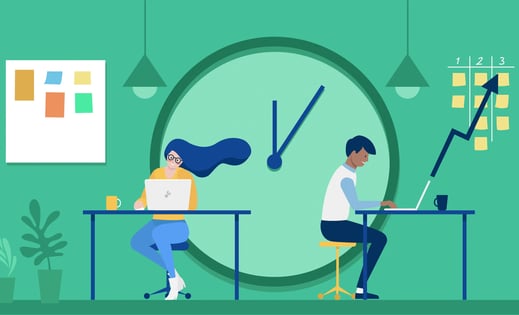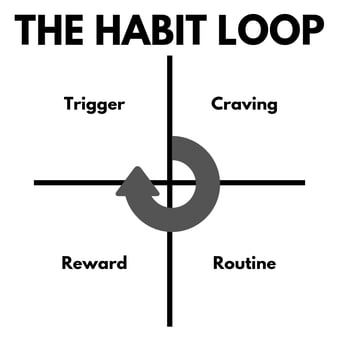What's the first thing you do after waking each morning?
Do you check your phone?
Jump out of bed?
Brush your teeth?
No matter what habit you have, it's started by a single cue. Habit triggers are powerful. They can establish a new routine or help you break a bad habit, so long as you understand how to use them.
And if you can harness the strength of triggers, there's no stopping how productive you can become.
Using Habit Triggers for Productivity Breakthroughs
Triggers are what kick off a habit's loop. They initiate a craving for something that drives you into a routine, so you can earn the reward you're after.
Trigger. Craving. Routine. Reward.
The entire loop appears incredibly simple, but when you look at your own life, finding what triggers your habits can be difficult. We'll break down the types of triggers and how you can reset your own to create habits that make you more productive than ever.
What are habit triggers?
Triggers are necessary to kick off the habit loop. Without a trigger, you have no habit and vice versa. It's like "the chicken or the egg" question, only this one helps you brush your teeth more consistently.
On average, habits take 66 days to become second nature. The more you associate a trigger to a habit, the more automatic it becomes. The simplest way to make habits stick faster is to consciously acknowledge the trigger as you try to form new routines. This makes you more aware of the overall process and more apt to stick with it.
The opposite can be said if you use triggers less often. Habits will continually grow weaker. This is how you can interrupt bad habits. You can also set triggers to override them all together.
But before you can do that, you need to know about the types of habit triggers so you can spot what initiates your craving and find the best one for changing your habits.
5 Habit Trigger Types
Triggers come in five categories, and you can use each depending on the needs of your habit. All are effective, but the scenario will dictate which works best. Whether building or removing a habit, these triggers are the key.
1. Time
Time is one of the most common triggers types because of our reliance on schedules. Even our biological clocks trigger habits.
Is there a time you usually go to bed at night? Many people rely on their circadian rhythm to tell them when to start their bedtime routine. For others, it's the actual time on a clock, and a mental alarm suffices in kicking off the habit.
Time is an extremely reliable trigger because we have the same hours every day. The consistency allows for a trigger that sticks, and habits thrive on predictability.
2. Location
Any location we visit frequently has a habit attached to it. It could be the way you turn on the light, start the shower, then undress when you enter your bathroom in the morning. It could be the way you open the fridge or cupboards to look at a snack when you're in the kitchen (even if you're not hungry).
Location triggers are best for habits that take place in specific areas. For instance, when you enter your office, you sit at your desk and read some documents while your email client syncs. The habit is tied to entering your office. If you were at a conference and decided to finish some work in your hotel room, you may start reading through reports, not even realizing you didn't open your email.
3. Preceding Event
Preceding events rely on something happening during the day. When your phone gets a notification, you check it. When your coffee is ready, you read the news.
Preceding events offer the possibility of habit stacking. After the completion of one habit, you immediately move into the next because they're all tied into one longer routine. This is incredibly effective for stringing related tasks together to increase productivity.
4. Emotional State
Your emotional state is a difficult source for building positive triggers. If you always go for runs when you're happy, you've found a rare example of a good emotionally triggered habit. For the most part, humans feed bad habits because of their emotions. We eat when we're sad, we drink when we're lonely, we smoke when we're stressed, we open social media when we're bored.
The reason positive habits are difficult to build with these triggers is that we rarely have complete control over our emotions. If we were only to initiate a positive habit when we're grateful, we might not go through that routine for weeks if we hit a particularly rough patch in life.
Instead, it's important to be aware that emotional triggers are often linked to negative habits so you can work at breaking those, rather than trying to build inconsistent new ones.
5. Other People
Using other people to trigger habits is something that can be of great benefit if implemented correctly.
You may not be aware of how other people currently affect your behavior. When you see your boss, does your demeanor change? When you hang out with a specific friend, do you find yourself having a few more drinks than usual?
Tie habits to other people. For instance, every Thursday may be date night for a couple. The time will vary, but when seeing each other that evening, they both relax a bit and embrace the date.
Picking your Habit Trigger
So now that you know the types, you need to understand what's required of a trigger to be effective. Using these four criteria will help you create one that sticks and works flawlessly for building your habits.
- Specific: You want to be as specific as possible when, so there's no way to interpret it otherwise. "During my lunch break" becomes "At the start of my lunch break."
- Consistent: The trigger needs to be reliable, so basing it on an infrequent event won't work. "Before I make breakfast" becomes "When I get out of bed."
- Automatic: You want the trigger to happen without requiring effort to remember, otherwise, it's not doing its job as a trigger. "After work" becomes "At 5:00, when I punch out."
- Unavoidable: There can't be any way around the trigger. "When passing the gym" becomes "When I put my shoes on."
Creating Habit Triggers that Work
The first step to increasing productivity with your triggers is to decide what habit you want to build. The simpler the habit, the more likely it is to stick, and if you use the information above, you can create larger stacks to increase productivity.
Let's say you want a more productive morning routine. You want to meditate, make coffee, plan your day, and get in some movement. Written out, this would look like the following:
"When I enter the kitchen after waking up, I'll make a cup of coffee. While my coffee is brewing, I'll meditate for ten minutes. When my alarm sounds, I'll go through my stretching routine. After completing my stretches, I'll pour myself a cup of coffee and plan my day."
This is an incredibly simple stack, but you can see how effective they can be. It streamlines the entire morning. The whole stack relies only on you entering your kitchen in the morning, and keeping a stock of coffee beans.
If you're someone who gets coffee on the way to work a few days a week, you'd need a different trigger to ensure you're consistent with the habit.
James Clear, author of Atomic Habits, recommends making a list with two columns. The first column tracks all the habits you do every day, no matter what. The second is a list of everything that happens to you without fail. Use these lists to form your own habit stack by pairing tasks and using preceding events as your trigger.
Mastering Productivity Habits
There are many small things you can do to increase the chances of a habit sticking. Placing your running shoes at the bedroom door, so you remember to jog a few miles. Setting alarms on your phone to remind you of a specific time. They all work as triggers to reinforce the overall routine.
If you're using triggers to change a bad habit, keep in mind you can never fully eliminate one. Bad habits are replaced, meaning there's always the possibility they resurface if you're not diligent.
If a particular trigger isn't working, test the other types until you find what fits best for that specific habit. The right trigger will feel natural and increase your productivity without even thinking about it.
Help your marketing team establish better habits by coaching them through their triggers. Our guide, How to Build the Ideal Marketing Team explains how we've hired top talent to make Lean Labs a more productive brand.






